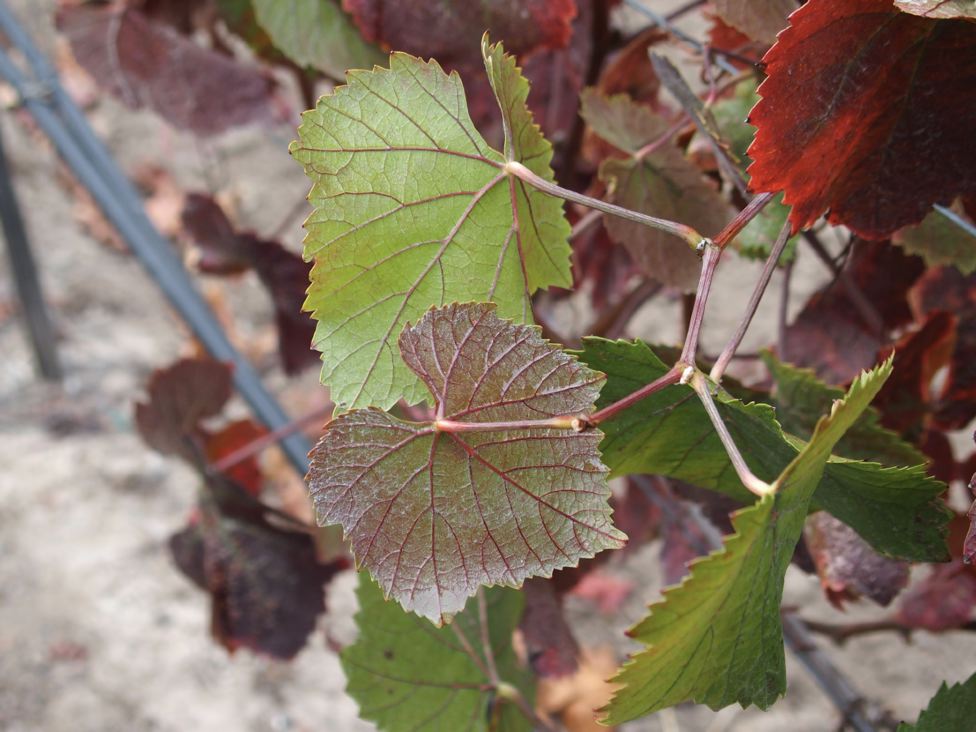Grapevine Red Blotch Virus: An Untreatable Vineyard Infestation that is Kept Hushed
“We think Red Blotch is the next big issue for California and the impact
is like phylloxera in the late 80s and early 90s”
Bruce Cakebread, Cakebread Cellars, Napa Valley
Bruce Cakebread is one of the few vintners to speak out about Grapevine Red Blotch Virus (GRBaV). At a
tasting in London in 2017, he told db - https://www.thedrinksbusiness.com/2017/02/red-blotch-like-phylloxerafor-
california/ - that he had pulled out 22 acres of Cakebread vineyards due to the virus and noted that many
vineyards were being ripped up and being replanted with virus-free vines. The wine industry is naturally
reluctant to speak openly about the virus infestation for fear of consumer perception that the virus infestation
affects the quality of wine produced. Simply, wineries do not want consumers to think there is a major problem.
I wrote previously about red blotch in the PinotFile, www.princeofpinot.com/article/1743/, and in the Oregon
Wine Press, www.oregonwinepress.com/beating-red-blotch. This article provides updated information and an
interested consumer’s timeline and summary. The photo above shows red blotch in a Pinot Noir vine in the Russian River Valley.
TIMELINE
2008: Viticulturist Jim Wolper and Viticulture Researcher Mike Anderson, both of UC Davis, first discovered
the disease at the UC Davis Oakville Station Experimental Vineyard in Napa Valley in Cabernet Sauvignon
vines planted in 2001. The vines exhibited leaf changes resembling those caused by leafroll-associated virus
(GLRaV), lower Brix, and delayed harvest, but the vines tested negative for the leafroll virus. The Red Blotch
virus was in 46% of the vines.
October 7-12, 2012: The Red Blotch virus was first reported to the scientific community at the 17th
Congress of the International Council for the Study of Virus and Virus-Like Disease of the Grapevine (ICVG)
held at Davis, California by researchers at both UC Davis and Cornell University who had been working
independently and concurrently. It was agreed at ICVG to refer to the virus as the “Grapevine Red Blotch associated
Virus or GRBaV. This plant virus is a member of the genus Grablovirus of the family Geminiviridae. .
October 2012: The complete genome sequence of the Red Blotch virus was achieved soon after GRBaV
was reported at the ICVG. A DNA-based polymerase chain reaction (PCR) assay was developed in
cooperation with Marc Fuchs, a plant pathologist at Cornell University and Eurofins STA Laboratories. The test
detects GRBaV in any tissue of the vine, including leaf blades, petioles, clusters, green or dormant canes,
cordons and trunks during any season. The virus is discoverable before the onset of symptoms in the affected
grapevine.
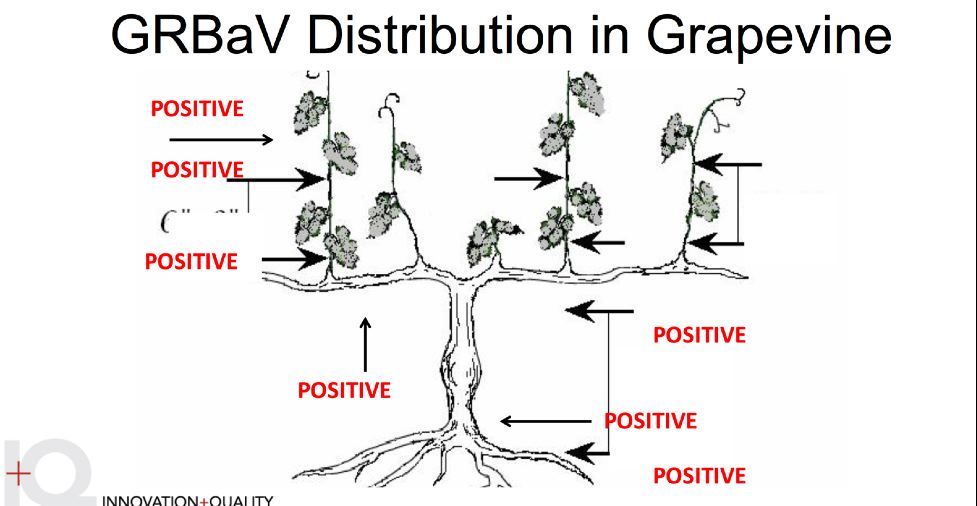
2013: Dr. Mysore Sudarshana, a plant pathologist with the USDA Agricultural Research Service at UC Davis
and Maher Al Rwahnih, a researcher at UC Davis Foundation Plant Services (FPS) published the first report of
the GRBaV virus associated with Red Blotch disease in Cabernet Franc, Cabernet Sauvignon and Zinfandel
grapevines in California. They used the PCR assay on grapevines that exhibited foliar signs of red blotches
and red veins accompanied by reduced Brix in the grapes at harvest.
2013: The Grapevine Foundation Block at Russell Ranch at UC Davis FPS was tested and was found to be
completely free of GRBaV. This vineyard is the primary source of wood for certified nurseries in the future.
GRBaV was found to have a low incidence (less than 1%) at the FPS Classic Foundation Vineyard.
2013: Dr. Mark Fuchs, a plant virologist at Cornell University, reported in a webinar that the red blotch virus
was spread by grafting and propagation and possibly the Virginia creeper leafhopper that was identified in
greenhouse experiments but not in the field. This vector was never confirmed by subsequent studies. Fuchs
noted that grapes from vines infected with the virus had lower Brix, reduced color and delayed ripening. He
recommended removing individually infected vines or replace the entire vineyard if more than 25% of the vines
are infected.
2014: The red blotch virus was found to be widely distributed in vineyards in California, Maryland, New York,
New Jersey, Oregon, Pennsylvania, Virginia and Washington, and reported in vineyards in Arizona, Arkansas,
Georgia, Idaho, North Carolina, Texas and Canada. 15 to 20 vineyards were infected in Oregon by early 2014,
and the virus was reported as spreading at an undetermined rate in Southern Oregon. So far, GRBaV has only been detected in Europe in Switzerland and the origin of the plants was California. Since the Swiss performed a large survey and did not find the virus elsewhere, GRBaV is considered a quarantine pathogen and the few infected plants were removed from the virus collection and destroyed.
2015: Anita Oberholster, a researcher in the Department of Viticulture and Enology at UC Davis, presented
her findings on how GRBaV can limit grape development and affect wine made with grapes from virus-positive
vines. Brix levels are consistently lower, and bottled wines made with grapes from GRBaV-positive vines
showed reduced fruit character, “artificial fruit” flavors, and a thinner mouthfeel marked by green tannins.
2015: M. Al Rwahnih, A. Rowhani and De. Golino from UC Davis analyzed specimens originally collected by
Professor Harold Olmo at UC Davis between 1937 and 1950. The study suggested that GRBaV was present in
California vineyards (at least where specimens were taken) 78 years ago.
2015: Dr Mark Fuchs and colleagues at Cornell University reported at the 18th ICVG that through
agroinoculation experiments they had confirmed Koch’s postulates and the hypothesis that GRBaV was the
causal agent of red blotch disease.
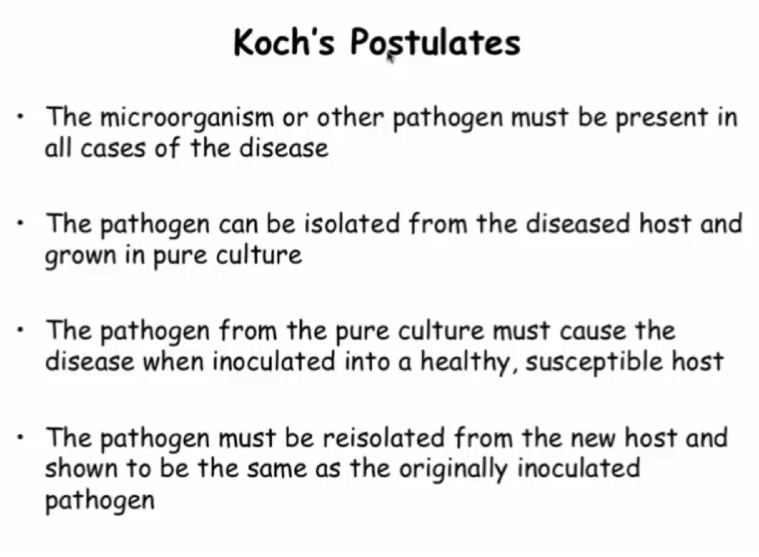
2015: Dr. Mysore Sudarshana reported that the symptoms of red blotch disease in red-berried grapevine
cultivars such as Pinot Noir first appear in June to July in the Northern Hemisphere as irregular blotches on
older leaf blades on the basal portions of shoots. The blotches can expand and coalesce across most of the
leaf blade and progressively move toward the top of the canopy late in the season (August to October in the
Northern Hemisphere). Affected leaves may drop off prematurely. There are variations in reddening depending
on the cultivar and rootstock. GRBaV in Pinot Noir is pictured below. The changes resemble leafroll disease
due to GLRaV, but the leaf margins in GRBaV-infected wines do not roll downward, and the leaf veins in red
blotch turn partly or fully red while leafroll-infected vines exhibit green veins. A comparison of red blotch and
leafroll is pictured below. Also, a typical example of GRBaV is pictured. The effects of GRBaV are much more
devastating than leafroll.
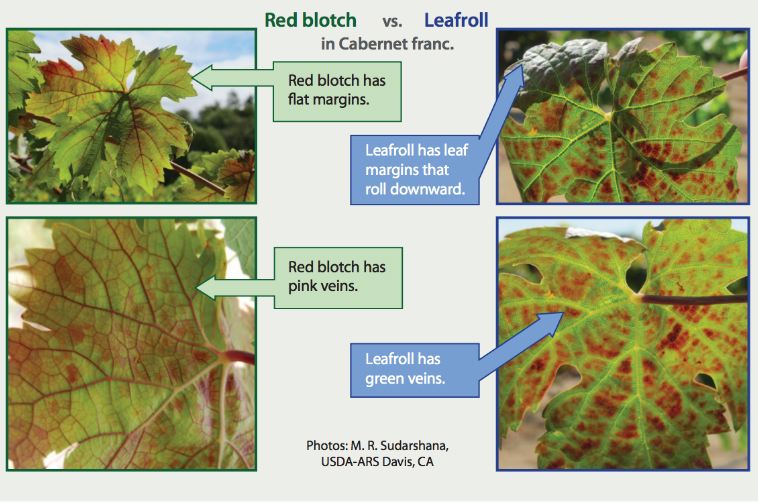
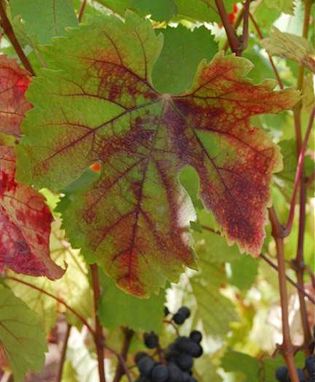
2016: A possible vector was discovered by researchers at UC Davis headed by Brian Bahder and confirmed
by field and greenhouse studies by Marc Fuchs et al. The three-cornered alfalfa treehopper, Spissistilus
festinus, was found to be a vector under greenhouse conditions, that is, the vector spread GRBaV virus from
infected to healthy vines. It was soon found by researchers that overwintering adults in vineyards that were
infected with the virus in the salivary glands indicated that they would be capable of spreading the virus (but
more research needed to be done). The three-cornered alfalfa treehopper prefers alfalfa, soybean and bean,
all leguminous plants. The finding did not rule out the possibility of other vector species such as other
treehopper species, leafhoppers, planthoppers and plant lice, and more confirmation was needed in the field.
University of California at Berkeley entomologist, Dr Kent Daane, reported that he did not believe there was
any conclusive evidence of a vector and he recommended that suspicious vectors should not be treated
with insecticides because of red blotch.
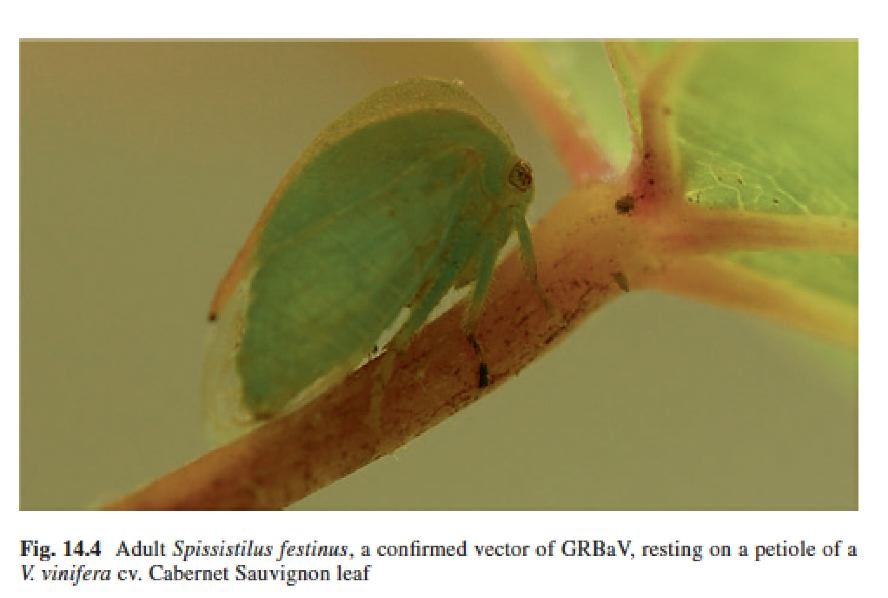
2016: It is reported that there is no cure for a vine infected with GRBaV. If there are a few symptomatic vines
(<25%-30%), it is recommended that the vines be removed during the dormant season when insect activity is
very low or absent and replanted with clean vines. If more than 30% of vines are diseased, then the entire
vineyard should be removed. Some recommend that the ground be left fallow for 2 years before replanting.
Prevention includes planting certified vines from virus-tested, clean stocks. Michael Anderson at UC Davis
spoke to the spread of the virus, saying, “The most important issue concerning red blotch is understanding the
mechanism(s) of vine-to-vine spread. It is one thing to do everything you can to ensure clean planting material,
but it is quite another to keep it that way.”
2016: Steve Dutton, noted wine grower in Sonoma County, reported that a young Chardonnay vineyard
developed red blotch five years after the vines were planted and the entire vineyard had to be replaced. The
grapes would not ripen above 22º Brix.
2016: A study by a research team headed by Vaughn Walton of Oregon State University, found 29.79% of 356
vines tested positive for GRBaV in Southern Oregon in 2016, and 4.19% of 406 sampled vines tested positive
in the Willamette Valley. Spread in the Willamette Valley was quite variable. Leafhoppers were commonly found
in the vineyards tested. The increased incidence in young healthy vines adjacent to infected vineyards
suggested vector transmission.
2016: Bob Martin, of the USDA-ARS in Corvallis, Oregon reported that the virus had been discovered in all
wine-producing areas of Oregon in vineyards 2 to 35 years of age. Cultivars testing positive included Barbera,
Cabernet Sauvignon, Cabernet Franc, Grenache, Malbec, Merlot, Pinot Noir, Syrah, Tempranillo, Chardonnay,
Muscat, Pinot Gris, Roussanne and Viognier.
2016: The spread of red blotch in the field is acknowledged by many researchers and confirmed by PCR
assay data. The spread patterns reflect a vector. GRBaV has been discovered in wild grapevines.
2016: A panel moderated by Jim Barbour, viticulturist and owner of Barbour Vineyards, discussed “Effects of
Red Blotch on Wine Quality.” A Knight’s Valley Vineyard was planted in 2004-2006. The first symptoms of red
blotch appeared in 50 vines in 2010. It had spread to 4,000 vines by 2011. The affected vines tested positive
for red blotch once the test was developed.
2016: Rebekah Wineburg, winemaker at Quintessa, reported on “Effects of Red Blotch on Wine Quality.” Red
blotch was identified in a Cabernet Sauvignon block planted in 2009 with symptoms first observed in 2011. The
vines were removed post-harvest 2015. Harvest chemistry:
2016: Agdia, Inc. in Elkhart, Indiana commercialized a rapid and user-friendly DNA test kit for detecting
GRBaV in grapevines. The test is much faster than other methods and is usually completed in 45 minutes or
less including the sample extraction step. Agdia claims the test is at least ten to one hundred times more
sensitive than laboratory-based PCR methods but can be completed in a fraction of the time by nonexperienced
users.
2016: In-field diagnostics are in development as the virus can be hard to detect by visual means. Grapevines
may have multiple viruses at the same time, including leafroll virus, that produce other symptoms. Confounding
the diagnosis is the finding that vines can test positive by DNA-based assay for the virus but have no
symptoms or symptoms may appear in one vintage and not another.
2017: Scientists at UC Davis report that GRBaV infections disrupt normal berry development and stress
responses by altering transcription factors and hormone networks, resulting in the inhibition of ripening
pathways involved in the generation of color, flavor and aroma compounds. The result is Brix reduction by up to
6º, decreased berry weight, reduced grape color, delayed ripening, and diminished yields. Wines made from
diseased vines can show reduced pH and elevated TA, and disturbed phenolics and tannins compared to
wines from non-diseased vines. In essence, once a grapevine is infected and symptoms appear, the grapevine
may not produce commercially useful grapes.
2017: Marc Fuchs in Growing Produce - https://www.growingproduce.com/fruits/grapes/understanding-theeconomics-
of-red-blotch-in-grapes/ - re-emphasized there is no cure for red blotch. “Once a vine is infected
with red blotch, it remains infected with red blotch until it dies.” The problem is, he pointed out, “It doesn’t kill
the vine, so growers are still making a crop but very often they are not aware of how much money they’re
losing and how poor the crops is. We underestimate incidents and impacts that this disease and virus has on
the industry (see below) Fuchs believes the economic threshold between removing infected vines or an entire
vineyard was 30%. He cautioned that growers be very choosy when planting new vines and make sure the
new vines and rootstock have been virus tested and are clean material.

April 2017: Dr. Vaughn Walton, Professor and Horticultural Entomologist in the Oregon State University
Department of Horticulture had a presentation at the 2018 Oregon Grape Day held by the Oregon Wine
Research Institute at Oregon State University titled “Red Blotch in Oregon.” During 2016, he found three
potential virus vector insects in Oregon vineyards. The treehopper Spissistilus festinuswas found in Southern
Oregon and recorded in all production regions throughout Oregon during the last 100 years (data from OSU
insect collection). He additionally found the treehopper species Tortistilus wickhami and Tortistilus
albidosparsus in Oregon vineyards. The former was found predominantly in Southern Oregon while the latter
was predominantly found in the Willamette Valley. All suspected vector insect species were consistently found
in vineyards where GRBaV spread year over year. The spread of GRBaV is alarming, with observed
doubling and 10X increases in study sites from 2014-2016. Treehoppers are believed to be the most like
species moving red blotch between vines. The patterns of virus spread within vineyards closely link feeding
symptoms of treehoppers. GRBaV-infected plants are concentrated and spread from the edge of the sampled
vineyard blocks. Virus transmission biology work is currently ongoing in greenhouse trials.
Another presentation by Dr. Anita Oberholster et al of UC Davis Cooperative Extension titled “Impact of Red
Blotch Disease on Grape and Wine Composition,” was based on research in Sonoma County vineyards from
2014 to 2016. She concluded that the impact of red blotch was not variety but site specific with significant
seasonal effect. The differences in sugar concentration at harvest resulted in significantly higher alcohol
concentrations in wines made from fruit from healthy/asymptomatic vines compared to symptomatic vines,
which strongly affected sensory properties.
December 2017: Deborah Golino, Director of FPS at UC Davis, reported that GRBaV had been found in
the Russell Ranch Vineyard. All of the five of 4,132 vines that tested positive for GRBaV were removed and
destroyed. This is the first time that the virus has been detected since testing began in 2013. All mother vines
and vines related to GRBaV positives tested negative in every case, indicating that this is a field transmission
of GRBaV. The one vine that tested positive in the Classic Foundation Vineyard was removed. FPS plans to be
more vigilant and additional precautions are being undertaken to prevent spread of this viral disease. The
complete details are at http://fps.ucdavis.edu/newsarticle.cfm?newsid=19.
March 2018: The red blotch virus was found in Calaveras County. This followed recent findings of the virus
in El Dorado and Amador county vineyards.
April 2018: The Proceedings of the 19th Congress of ICVG, Santiago, Chile, revealed the following. Keith Perry and Marc Fuchs studied the spread of GRBaV over a four year period (2014-2017) in a Cabernet Franc vineyard in California a Merlot vineyard in New York. The findings of spread in the California vineyard revealed S. festinus as a vector for GRBaV and suggested further testing of other possible vectors.
May 2018: The California Department of Food and Agriculture approved $3.4 million in funding for research
focused on grapevine viruses. The research will include the role of treehoppers in relation to red blotch disease
and the seasonal ecology and transmission efficiency of insect vectors such as the three-cornered alfalfa
hopper.
2018: Vintner Merry Edwards said in an interview that the Mt Eden clone is resistant to leafroll and red blotch
virus. She stated, “There is a lot of the material we have today that has failed with red blotch. A lot of the
imported clones, the Dijon series clones, a lot are infected. It’s very hard to find something clean to plant today,
but I have my own little miracle. The fact that the Mt Eden clone would be resistant to red blotch is just amazing
to me and I guess it’s my gift from the universe to Merry.”
2018 I talked with Glenn Alexander, who until this year owned Atlas Vineyard Management, a large vineyard farming (1600 acres) and vineyard development company based in Napa, California. He has observed red blotch in multiple vineyards in Sonoma County, primarily in vineyards planted in the late 1990s and early 2000s. The worst infestation he has seen is in Petite Sirah and Syrah, with Pinot Noir less widely affected and Chardonnay rarely infected with red blotch virus. The virus has been seen in fewer recently planted vineyards because of third party certification by nursery sources. In some vineyards, he "can live with it awhile" and has seen some vineyard grapes used for sparkling wine if the vineyard owner cannot afford to replant. He does not believe that red blotch is spread by pruning.
SUMMARY
* Grapes are one of most heavily virused crops in the world with 84 known RNA and DNA viruses in 32 genera identified worldwide.
* Grapevine red blotch-associated virus (GRBaV) is a viral disease first recognized in 2008, but present in
California vineyards for over 70 years. The virus has also been reported in wine and table grape
varieties in many United States growing regions, Canada and European countries. It infects every part of the
grapevine.
* The virus has been spread within nursery stocks over the past few decades that were ignorant of the threat
and among existing vineyards by vector leading to its current emerging prevalence. Most certified rootstock
was not tested for red blotch until recently. Dissemination occurred in the wine regions without suspected
vector by taking wood off of infected vines.
* There is speculation that the there is a latency of about 2 years between infection with the virus and
symptoms. The same vine may show symptoms at some times of the year and not at others or may vary with
weather conditions (ie more prevalent in drought) or may appear infected one season and not the next.
* The most likely vector is the three-cornered alfalfa treehopper, but researchers are still in the early stages of
fully understanding details of the spread of the virus. The treehopper has been found in the San Joaquin
Valley that is home to some nurseries that supply grapevines.
* It is thought that GRBaV is graft and cane transmissible, but probably not spread by root grafting or pruning.
* The spread of the GRBaV virus is more evident in riparian areas and irrigation reservoirs in or close to
vineyards. The epidemiology of GRBaV remains elusive.
* The result of GRBaV infestation is smaller berry size, delayed ripening, reduced Brix, lower pH, increased TA,
lower yields and ultimately significant reduction in the quality of the wine.
* No cure for the virus has been discovered or developed. Once a vine is infected with red blotch or other virus
in grapes, there is no cure.
* Growers are advised to avoid planting or replanting vines in close proximity to vineyards that have tested
positive for GRBaV and that have insect vectors. If blocks in an established vineyard test positive for the
virus, it is recommended not to use that bud wood for propagation.
* Growers are recommended to walk the vineyard from bud break through senescence, mark plants and
create a pattern. If red blotch is suspected, test and look for patterns (patterns mean spread). Vintners should
look for diseased vines in the fall and test them along with healthy-looking vines in the same block since the
vines likely came from the same source material. If there is a mix of healthy and infected vines and there is
less than 20 percent (others set limit at 30%) of the vineyard infected, then rogue vines may be removed.
Otherwise, all vines must be removed. Approach replanting with caution.
* The future of red blotch prevention and other grapevine virus diseases may involve developing disease-resistant
grape varieties including genetically modified grapevines. Ted Lemon, the proprietor and winemaker
of Littorai in the Sonoma Coast has a different slant. He says, “From a viticultural point of view, most of our
leading researchers and government agencies take the approach of somehow trying to ‘guarantee’ that plant
material will be virus free. They have been singing this siren song for decades. Our plant material has never
been virus free. It is cleaner than ever, but not virus free. Our goal for people and plants ought not to try to
make them virus and disease free, but to create vibrant, healthy ecosystems where balance prevents disease
associated with virus expression. In the case of humans, the moral question pushes us to try to insure that no
one suffers from virus-induced disease and we err on the side of too much medicine. In the plant world, we
can more easily accept the risk that a percentage of plants fail if this create better health in the overall
population.”



